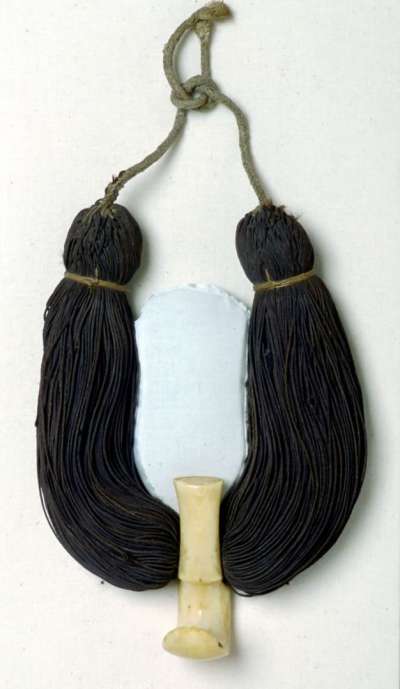Necklace
Lei niho palaoa of this size were a development of the early 19th century when whalers and traders began to supply sperm-whale teeth and walrus tusks in larger quantities. Examples with less strands of hair and smaller hook-shaped pendants are of an earlier date. During Cook’s voyages, for example, only the small examples have been collected. The large size of the hook pendant could have been a result of Kamehameha’s rule. Chief Kamehameha (who died in 1819) established control over the entire Hawaiian islands, eventually in 1810 founding a monarchy which ruled, increasingly nominally, for most of the 19th century. Kamehameha was known for commissioning larger sized wooden sculptures and these larger hook pendants might have been another outcome of his rule.
It is often assumed that the hair was taken from deceased chiefs, but due to the lack of grey hair this seems unlikely. During funerary rites, hair of male relatives was ritually cut and could have been used in these necklaces. Another source is the long hair of young women who had given birth to their first child. After her first child a woman would maintain a short hairstyle indicating her status as mother (for more information on the use of hair in Hawaiian objects, see Sowell 2013 – article attached).
The combination of highly valuable materials: human hair (lauoho) taken from the head which is the most important part of the body in Polynesia (containing mana or spiritual power) and ivory makes this an important and potent object that would have been reserved for the Hawaiian chiefly class (worn by both men and women).
It is often assumed that the hair was taken from deceased chiefs, but due to the lack of grey hair this seems unlikely. During funerary rites, hair of male relatives was ritually cut and could have been used in these necklaces. Another source is the long hair of young women who had given birth to their first child. After her first child a woman would maintain a short hairstyle indicating her status as mother (for more information on the use of hair in Hawaiian objects, see Sowell 2013 – article attached).
The combination of highly valuable materials: human hair (lauoho) taken from the head which is the most important part of the body in Polynesia (containing mana or spiritual power) and ivory makes this an important and potent object that would have been reserved for the Hawaiian chiefly class (worn by both men and women).
Object Summary
- Accession Loan No.
- E1279
- Category
- Ethnography
- Collection Class
- Personal ornament
- Material
- whale or walrus ivoryhuman hairolona fibre
- Common Name
- necklace
- Simple Name
- necklace
- Production County
- Hawai’i
- Production Country
- Hawaiian Islands (United States of America)
- Production Year High
- 1868


